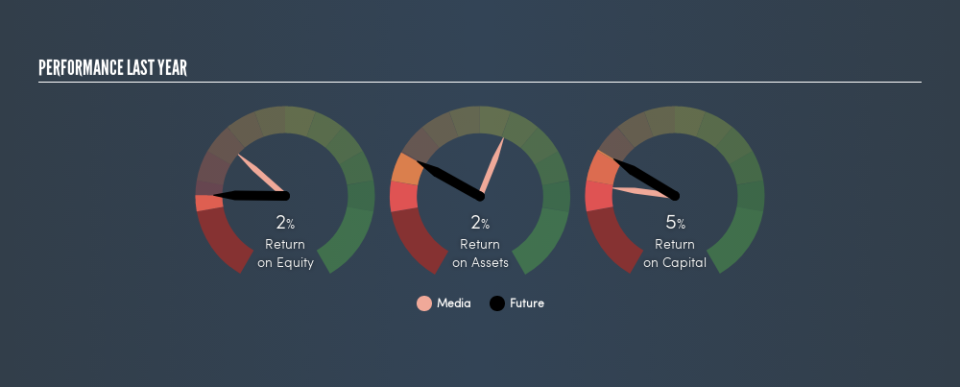Why We’re Not Impressed By Future plc’s (LON:FUTR) 4.9% ROCE

Want to participate in a research study? Help shape the future of investing tools and earn a $60 gift card!
Today we'll look at Future plc (LON:FUTR) and reflect on its potential as an investment. Specifically, we're going to calculate its Return On Capital Employed (ROCE), in the hopes of getting some insight into the business.
First of all, we'll work out how to calculate ROCE. Next, we'll compare it to others in its industry. Then we'll determine how its current liabilities are affecting its ROCE.
What is Return On Capital Employed (ROCE)?
ROCE measures the amount of pre-tax profits a company can generate from the capital employed in its business. Generally speaking a higher ROCE is better. Overall, it is a valuable metric that has its flaws. Author Edwin Whiting says to be careful when comparing the ROCE of different businesses, since 'No two businesses are exactly alike.'
How Do You Calculate Return On Capital Employed?
The formula for calculating the return on capital employed is:
Return on Capital Employed = Earnings Before Interest and Tax (EBIT) ÷ (Total Assets - Current Liabilities)
Or for Future:
0.049 = UK£9.7m ÷ (UK£255m - UK£58m) (Based on the trailing twelve months to September 2018.)
Therefore, Future has an ROCE of 4.9%.
Check out our latest analysis for Future
Does Future Have A Good ROCE?
When making comparisons between similar businesses, investors may find ROCE useful. We can see Future's ROCE is meaningfully below the Media industry average of 8.5%. This could be seen as a negative, as it suggests some competitors may be employing their capital more efficiently. Separate from how Future stacks up against its industry, its ROCE in absolute terms is mediocre; relative to the returns on government bonds. Investors may wish to consider higher-performing investments.
As we can see, Future currently has an ROCE of 4.9% compared to its ROCE 3 years ago, which was 2.1%. This makes us think about whether the company has been reinvesting shrewdly.
When considering ROCE, bear in mind that it reflects the past and does not necessarily predict the future. ROCE can be deceptive for cyclical businesses, as returns can look incredible in boom times, and terribly low in downturns. ROCE is, after all, simply a snap shot of a single year. Since the future is so important for investors, you should check out our free report on analyst forecasts for Future.
How Future's Current Liabilities Impact Its ROCE
Current liabilities include invoices, such as supplier payments, short-term debt, or a tax bill, that need to be paid within 12 months. The ROCE equation subtracts current liabilities from capital employed, so a company with a lot of current liabilities appears to have less capital employed, and a higher ROCE than otherwise. To counter this, investors can check if a company has high current liabilities relative to total assets.
Future has total liabilities of UK£58m and total assets of UK£255m. As a result, its current liabilities are equal to approximately 23% of its total assets. This is a modest level of current liabilities, which would only have a small effect on ROCE.
The Bottom Line On Future's ROCE
With that in mind, we're not overly impressed with Future's ROCE, so it may not be the most appealing prospect. You might be able to find a better buy than Future. If you want a selection of possible winners, check out this free list of interesting companies that trade on a P/E below 20 (but have proven they can grow earnings).
If you are like me, then you will not want to miss this free list of growing companies that insiders are buying.
We aim to bring you long-term focused research analysis driven by fundamental data. Note that our analysis may not factor in the latest price-sensitive company announcements or qualitative material.
If you spot an error that warrants correction, please contact the editor at editorial-team@simplywallst.com. This article by Simply Wall St is general in nature. It does not constitute a recommendation to buy or sell any stock, and does not take account of your objectives, or your financial situation. Simply Wall St has no position in the stocks mentioned. Thank you for reading.

 Yahoo Finance
Yahoo Finance 
